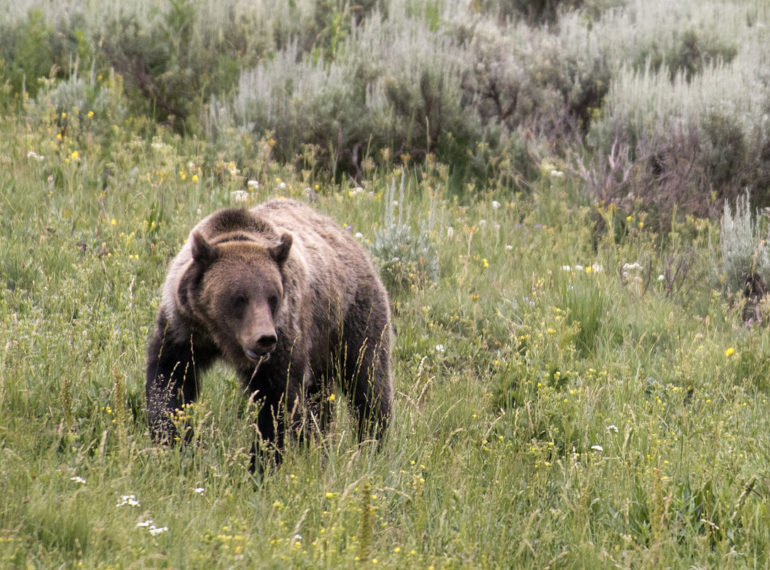After court decision on Great Lakes wolf delisting, conservationists say their legal claims are bolstered.
by Mike Koshmrl/Jackson Hole News & Guide | AUGUST 2, 2017
A U.S. Court of Appeal’s ruling Tuesday about wolves that roam the Great Lakes states could have major implications for grizzly bears 1,000 miles away in the Yellowstone region.
After the court found that the U.S. Fish and Wildlife Service had improperly assessed how carving out and “delisting” the distinct segment of more than 3,000 wolves in the Upper Midwest affects the rest of the species, it vacated a rule that allowed Minnesota, Wisconsin and Michigan to manage the species.
Environmental attorneys halfway across the country in the Northern Rockies say it’s a ruling that helps their impending legal squabble over recently delisted Greater Yellowstone Ecosystem grizzly bears.
“We believe that the Yellowstone delisting rule has the same fatal flaw as the Great Lakes delisting rule,” said Andrea Santarsiere, a Victor, Idaho, resident and senior attorney for the Center for Biological Diversity. “This strengthens our claim.”
That flaw, or “fundamental error” in the words of U.S. Circuit Judge Patricia Millett, was that Fish and Wildlife did not address how “extracting” and delisting a population segment of wolves would affect remaining wolves in the species’ range.
“The Service cannot circumvent the Endangered Species Act’s explicit delisting standards by riving an existing listing into a recovered sub-group and a leftover group that becomes an orphan to the law,” Millett wrote in her opinion. “Such a statutory dodge is the essence of arbitrary-and-capricious and ill-reasoned agency action.”
Millett and her appeals court colleagues also found that federal managers improperly “brushed off” the substantial loss of wolves’ historical range as “irrelevant to the species’ endangered or threatened status.”
But the panel of judges, who ruled from Washington, D.C., did find that Fish and Wildlife’s general approach of delisting a “distinct population segment” complied with the Endangered Species Act. The analysis and execution, they found, is what was illegal.
“From our standpoint, that’s a positive piece of the case,” said David Willms, a policy advisor to Gov. Matt Mead. “The D.C. court recognized that the service can create a distinct population segment for the purpose of delisting a distinct population segment.”
Federal managers took the same “distinct population” approach in delisting the approximately 700 grizzlies in the Greater Yellowstone Ecosystem, a process that technically wrapped up Monday, when jurisdiction shifted to the states.
The Greater Yellowstone’s bears were deemed separate from four other isolated populations of grizzlies that roam the Lower 48. Those populations all trickle from Montana, Idaho and Washington into Canada, and include the Northern Continental Divide, Cabinet/Yaak, Selkirk and North Cascades grizzly bear recovery areas.
It’s debatable how substantively Fish and Wildlife assessed impacts on other grizzly populations when removing protections for the Greater Yellowstone’s grizzlies.
A 515-page delisting rule mentions the Northern Continental Divide population — the nearest grizzly recovery area, at approximately 70 miles away — on 48 occasions. The smaller and more distant Cabinet/Yaak, Selkirk and North Cascades populations are mentioned in the rule much more sparingly: between six and eight times.
Santarsiere’s take is that there was scant analysis about how hunting Yellowstone grizzlies could affect other populations.
“One of the big issues with the Yellowstone grizzly delisting is that they’re delisting small populations of grizzlies that are only occupying 5 percent of the historic range, and they’re isolated,” she said. “So if grizzly bears are hunted and only protected in that arbitrary [monitoring area], then the chances of Yellowstone grizzlies reaching other populations is very slim.”
When federal managers were preparing a delisting rule for Yellowstone grizzlies in 2016 and early 2017, the Great Lakes wolf case was still in limbo. It remains to be seen if Fish and Wildlife will take action to amend its grizzly delisting rule or wait for the courts to decide its legality.
Hilary Cooley, the agency’s grizzly bear recovery coordinator, said she’s waiting to hear from Department of Justice and Interior attorneys on how to proceed.
“They’re the ones who really help us understand how this might affect anything in the future,” Cooley said. “But we’ll be looking at it for sure.”

